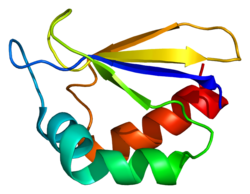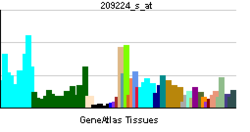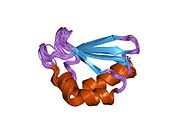- NDUFA2
-
NADH dehydrogenase [ubiquinone] 1 alpha subcomplex subunit 2 is an enzyme that in humans is encoded by the NDUFA2 gene.[1][2][3]
References
- ^ Ton C, Hwang DM, Dempsey AA, Liew CC (Jan 1998). "Identification and primary structure of five human NADH-ubiquinone oxidoreductase subunits". Biochem Biophys Res Commun 241 (2): 589–94. doi:10.1006/bbrc.1997.7707. PMID 9425316.
- ^ Emahazion T, Brookes AJ (Nov 1998). "Mapping of the NDUFA2, NDUFA6, NDUFA7, NDUFB8, and NDUFS8 electron transport chain genes by intron based radiation hybrid mapping". Cytogenet Cell Genet 82 (1-2): 114. doi:10.1159/000015081. PMID 9763676.
- ^ "Entrez Gene: NDUFA2 NADH dehydrogenase (ubiquinone) 1 alpha subcomplex, 2, 8kDa". http://www.ncbi.nlm.nih.gov/sites/entrez?Db=gene&Cmd=ShowDetailView&TermToSearch=4695.
Further reading
- Walker JE, Arizmendi JM, Dupuis A, et al. (1992). "Sequences of 20 subunits of NADH:ubiquinone oxidoreductase from bovine heart mitochondria. Application of a novel strategy for sequencing proteins using the polymerase chain reaction.". J. Mol. Biol. 226 (4): 1051–72. doi:10.1016/0022-2836(92)91052-Q. PMID 1518044.
- Dunbar DR, Shibasaki Y, Dobbie L, et al. (1997). "In situ hybridisation mapping of genomic clones for five human respiratory chain complex I genes.". Cytogenet. Cell Genet. 78 (1): 21–4. doi:10.1159/000134618. PMID 9345899.
- Loeffen JL, Triepels RH, van den Heuvel LP, et al. (1999). "cDNA of eight nuclear encoded subunits of NADH:ubiquinone oxidoreductase: human complex I cDNA characterization completed.". Biochem. Biophys. Res. Commun. 253 (2): 415–22. doi:10.1006/bbrc.1998.9786. PMID 9878551.
- Zhang QH, Ye M, Wu XY, et al. (2001). "Cloning and functional analysis of cDNAs with open reading frames for 300 previously undefined genes expressed in CD34+ hematopoietic stem/progenitor cells.". Genome Res. 10 (10): 1546–60. doi:10.1101/gr.140200. PMC 310934. PMID 11042152. http://www.pubmedcentral.nih.gov/articlerender.fcgi?tool=pmcentrez&artid=310934.
- Strausberg RL, Feingold EA, Grouse LH, et al. (2003). "Generation and initial analysis of more than 15,000 full-length human and mouse cDNA sequences.". Proc. Natl. Acad. Sci. U.S.A. 99 (26): 16899–903. doi:10.1073/pnas.242603899. PMC 139241. PMID 12477932. http://www.pubmedcentral.nih.gov/articlerender.fcgi?tool=pmcentrez&artid=139241.
- Brockmann C, Diehl A, Rehbein K, et al. (2005). "The oxidized subunit B8 from human complex I adopts a thioredoxin fold.". Structure 12 (9): 1645–54. doi:10.1016/j.str.2004.06.021. PMID 15341729.
- Gerhard DS, Wagner L, Feingold EA, et al. (2004). "The status, quality, and expansion of the NIH full-length cDNA project: the Mammalian Gene Collection (MGC).". Genome Res. 14 (10B): 2121–7. doi:10.1101/gr.2596504. PMC 528928. PMID 15489334. http://www.pubmedcentral.nih.gov/articlerender.fcgi?tool=pmcentrez&artid=528928.
- Vogel RO, Dieteren CE, van den Heuvel LP, et al. (2007). "Identification of mitochondrial complex I assembly intermediates by tracing tagged NDUFS3 demonstrates the entry point of mitochondrial subunits.". J. Biol. Chem. 282 (10): 7582–90. doi:10.1074/jbc.M609410200. PMID 17209039.
PDB gallery Categories:- Human proteins
- Chromosome 5 gene stubs
Wikimedia Foundation. 2010.



